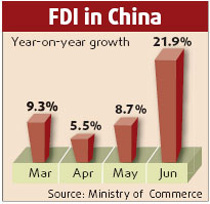Anything multiplied by 1.3 billion is a huge number. Lighting is a perfect example.
If the Chinese replace 1.3 billion 60-watt incandescent bulbs for 10-watt energy-saving bulbs, the saved electricity will exceed the capacity of the Three Gorges dam, the world's largest hydropower plant.
While these figures are based on estimates, energy-efficient lighting has become a driving force of the industry.
Wang Jinsui, president of the China Illuminating Engineering Society (CIES), said an incandescent bulb phase-out plan deserves serious consideration and that the government is taking various measures to encourage the use of energy-efficient lighting devices.
"The restriction of incandescent bulbs has been put on the agenda and the large-scale use of compact fluorescent lights (CFLs) is also under discussion," said Wang, who has been pushing for energy savings in the lighting industry for the past decade.
It is estimated that there are still about 4 billion incandescent bulbs in China, most of them in smaller cities and rural areas.
Light bulbs have been used since 1870s, but they are believed to be less efficient because 95 percent of energy is wasted in the form of heat.
Australia announced earlier this year to halt the use of incandescent bulbs before 2010. Canada, New Zealand, Chile, and four states in the US have also made similar moves.
In March, EU governments called on the European Commission to impose energy efficiency requirements on commercial and private uses, but the latter has not yet made a decision.
The CIES' Wang said China has been promoting a green lighting initiative since 1996 and saved 5 billion kilowatt hours of electricity from 1996 to 2005 while reducing CO2 emissions by 14.52 million tons.
The Chinese government has stipulated that only green light products be used in central government agencies.
The trend of energy-saving lighting devices is also taken as a huge opportunity for the lighting industry.
"New lighting technology offers a triple win - consumers and end users, the environment and business - all will gain and benefit," Gerard Kleisterlee, chairman and CEO of Royal Philips Electronics, said during his visit to Chongqing in June.
Tommy Leong, vice-president and general manager for Philips Lighting China, said his company's light bulb sales in the market declined by 20 percent, but those of CFLs rose by 40 percent. About 80 percent of Philips lighting products sold in China are also energy-efficient.
Philips now has nine lighting factories in China and supplies 80 percent of the CFLs to its global customers.
CNLight, a domestic lighting solution provider, saw its 2006 revenues increase by 37 percent to 269 million yuan, while profits grew by 40 percent year-on-year to 43.83 million yuan.
Chai Guosheng, chairman and general manager of the Nanhai, Guangdong Province-based company, attributed the growth to automobile lights and energy efficient products.
"When I set the aim to make the best energy-saving lights in China, in 1992 at the beginning of CNLight, many people thought I was crazy," Chai said. "But just because of the pursuit of this dream made CNLight successful."
With more than a decade of education and promotions, energy lighting has become an ordinary concept for families in large cities like Beijing and Shanghai and the penetration rate is as high as 70 percent, from 47 percent in 1995, according to CIES's Wang.
The focus has turned to smaller cities and rural regions, as well as some commercial uses.
Philips' Leong said the initial cost is still a barrier, because people are more concerned with the initial investment instead of the total cost of ownership.
A light bulb sells at about 1 yuan, but a quality energy-saving product is six times as expensive, which is especially a big factor for people and organizations in smaller cities and rural regions.
One approach Philips has taken is to rely on local development in its lighting research center in China.
Several years ago, the company developed a low-cost CFL product in China. Its price is about one-third of the previous mainstream product with a long life and good lighting effect. The product immediately won recognition from users and now a bulk of the Dutch firm's CFL exports are using that technology.
Leong said there are similar products in the pipeline, which combines cost and quality.
At the same time, it will spend a lot of resources in tier 2 markets. Traditionally, Philips is only strong in four metropolitan cities and 30 tier 1 one cities, but this year, Leong said his company will establish presence in 100 tier 2 cities, where the population is between 500,000 and 2 million.
(China Daily August 2, 2007)


